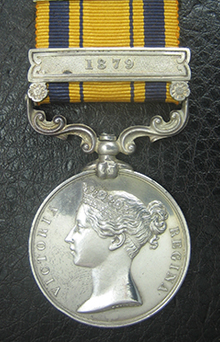
SOUTH AFRICA 1877-9, CLASP 1879 ‘TR. A E DIXON. NEWCASTLE MD RIFLES’.
Trooper Arthur Dixon of the Newcastle Mounted Rifles was the first European fatal casualty of the War when he drowned a couple of days after the action the unit were involved in at Sihayo's kraal. A letter published (copy included), possibly from his sister, gives details of what actually happened.
The Newcastle Mounted Rifles was a Northern Natal regiment raised in 1876, and served in the Zulu War of 1879 under Capt Bradstreet . After crossing the Buffalo River into Zululand at Rorkes Drift on 11th January 1879, the Newcastle Rifles had their first experience of coming under fire when they were part of the small detached force that took part in the first action of the War at Sihayo's kraal on 12th January. They spent the next days patrolling with the other Volunteer units present at Isandlwana with a strength of 14 but of these they lost half these men including Captain Bradstreet who was the senior Volunteer Officer present. Most of the men died in a last stand with Colonel Durnford and other Colonial Volunteers. Trooper Dixon, as well as the other members of the unit who died at Isandhlwana, are commemorated on a plaque in Newcastle (photos included).
The 11th of January dawned a gloomy day with drizzling rain early in the morning but despite this the crossing was commenced at 04h30. The mounted men and Natal Native Contingent crossed by the ford while the infantry were ferried over in the ponts which had been prepared. The crossing was covered by the artillery mounted on a knoll on which Fort Melvill was later erected and a screen of cavalry on the Zululand side, but no opposition was encountered. However, some of the Natal Native Contingent were drowned in the strongly flowing river. By 06h30 all the troops were across the river and the rest of the day was taken up by establishing a camp and moving the wagons, stores and equipment across. Lord Chelmsford rode off in a northerly direction to consult with Col Wood who had crossed the Blood River and camped near Bemba's Kop and when Chelmsford returned he had an interview with Col Durnford who had ridden across from Krantzkop.
Due to the obstacle posed by the wide sandy bed of the Batshe River and the rocky ridges beyond, it was evident that a track would have to be made before the column could advance, but Sihayo's kraal, situated in the Batshe valley threatened the left flank. Although Sihayo and his son Mehlokazulu were at Ulundi his actions had been one of the ostensible causes of the war and Chelmsford decided to attack his kraal. Early on 12 January the attacking force, consisting of cavalry scouting ahead, the Natal Native Contingent with the 1st Battalion in the lead and four companies of the 1st/24th in support, moved across the Batshe to attack a rocky gorge into which Sihayo's men had retreated, driving their cattle before them. The Natal Native Contingent showed reluctance to face the Zulus, some of whom were armed with rifles. Stones were also rolled down on the attackers. After a sharp action the Zulus retreated, having lost 30 dead and 4 wounded while 10 were captured. On the British side, two of the Natal Native Contingent were killed and twelve wounded, while one officer and two N.C.O.s had been wounded. The latter were taken back to the hospital at Rorke's Drift along with two badly wounded Zulus. Lieut Coghill fell from his horse and wrenched his knee in an attempt to catch a fowl but was able to remain with the column.
38 medals issued to unit, 37 with 1879 clasp. 8 unclaimed and broken up.
Condition GVF, minor EK. A very scarce and desirable unit let alone the rarity of being the first fatal casualty of the Zulu War.